This was published 8 years ago
Jordan is much more than it's biggest attraction, Petra
By Sandra Hall
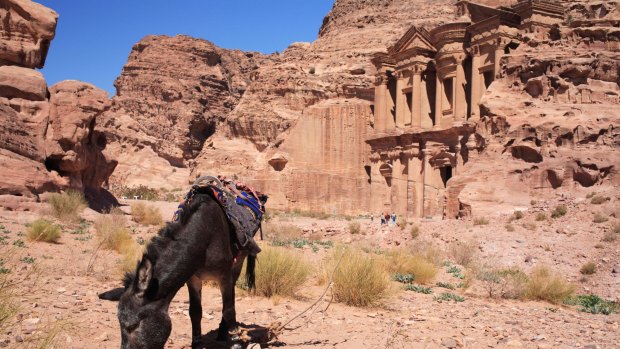
A donkey grazes outside Al Deir Monastery near Petra, Jordan.Credit: Prisma Bildagentur AG / Alamy
When I arranged a four-day tour of Petra and Jordan's other ancient sites, I hadn't counted on amplifying the experience with a report on the country's health service, but travel is full of surprises.
It was the donkey's fault. I had started up the 800 steps on the track to Petra's hilltop monastery, Al-Deir, when I looked up to see a sweet-faced little Bedouin boy riding one donkey down the steps and leading another. "Sorry," he said, as we both realised that there wasn't going to be room for all of us. The woman in front of me had already taken evasive action, leaping into the ditch beside the track, but she was wearing sneakers. I wasn't. I stood sideways, sucked in my stomach and hoped that the donkey would slide past me. But donkeys do not slide. They sway. And suddenly, I, too, was in the ditch, nursing a swollen foot which would no longer take my weight.
The donkey boy's big brother then appeared and offered me a ride down the hill on his donkey. The donkey's name was Shakira, he told me, and she was not usually ridden by tourists. It was an item of information designed to make me feel better but somehow it fell short. With the damaged foot dangling out of the stirrup, I gripped the pommel, hunched my shoulders and hung on, fearing for my life as Shakira delicately negotiated the slope and the steps. "Come on," her owner lied. "You look good. Lean back. Relax."
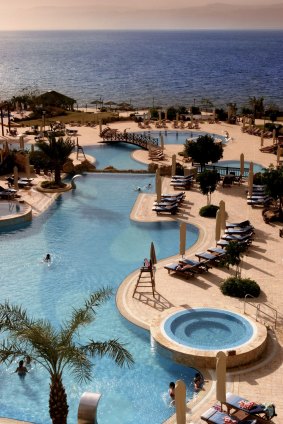
Jordan Valley Marriott Resort.
More reassuring was the news that a medical emergency room was handily located at the bottom of the track.
The doctor gave me a well-deserved talk on the wisdom of coming to Petra in the right shoes, diagnosed soft-tissue damage only and called for an ambulance to take me to hospital for an X-ray, just to be sure. At the same time, his assistant telephoned Yaseen, the travel company driver who was escorting me on the tour and he arrived at the hospital at the same time as I did.
Completely unflappable and infinitely kind, he wheeled me through the corridors, talked to the doctors and later found a walking stick to help me hobble around on the plaster brace and bandage I was now wearing. The ambulance was free and the X-rays cost me so little that I didn't bother to put in an insurance claim.
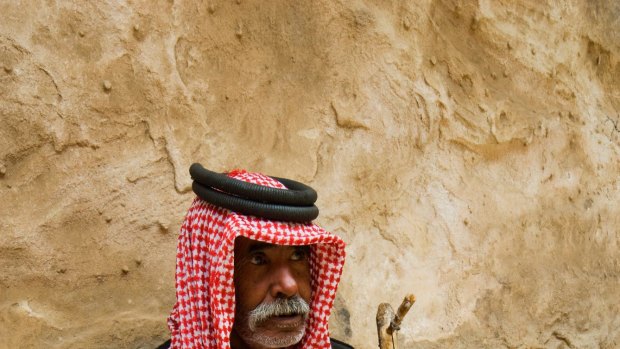
A Bedouin plays his stringed instrument in Jordan.Credit: Robert Harding Picture Library
Jordan takes great care of its tourists. Further proof came when a tourism policeman turned up to take a statement from me. He was smiling when he asked me if I wanted to file a complaint against the donkey but he wouldn't put away his notebook until I finally convinced him that I didn't want to make trouble for the donkey, its diminutive driver or any of their relatives.
Fortunately, I had already seen most of Petra's glories, which date back to its sixth-century BC beginnings when it was founded by the Nabataeans, a nomadic tribe of Arabian traders. I had also been to Little Petra, which is just a few kilometres away. A narrow sandstone canyon lined with equally beautiful Nabataean structures, it is often described as Petra's northern suburb and has a sleepy charm which is not shared by its big, bustling neighbour.
We arrived at sunset and shared it with just a few other tourists, along with a lone, white-robed Bedouin sitting on a comfortable rock. He looked as if he had arranged himself after studying the figures who appear in the work of David Roberts, the 19th-century Scottish painter who came to the area in the 1840s and turned out a succession of romantic watercolours of the ruins and the Bedouins who lived in and around Petra.
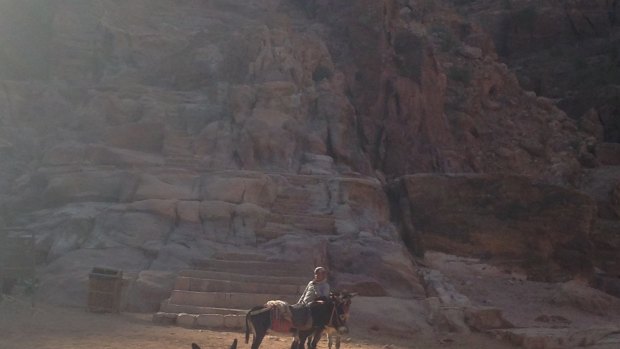
Donkeys at Petra, JordanCredit: Sandra Hall
As I walked towards their descendant, he pointed me towards a pillared facade set into the sandstone cliff above the road. This was the remains of the Painted House, a Nabataean "biclinium" or dining hall, celebrated for the frescoes of flowers, vines, birds and mythical figures which decorate its ceiling. Obscured for centuries by layers of soot from the smoke of countless Bedouin camp fires, the frescoes were restored four years ago by a team from Britain's Courtauld Institute.
And today I had the Painted House to myself, except for a bare-chested German tourist and his movie camera. He, too, climbed the steps to the biclinium but he didn't go inside. He just stood with arms outstretched in a "look at me" pose while his girlfriend filmed him.
I went on to the end of the gorge where a steep flight of roughly made steps led to an opening in the cliff with a small platform. Here I watched the shadows lengthening across the valley below.
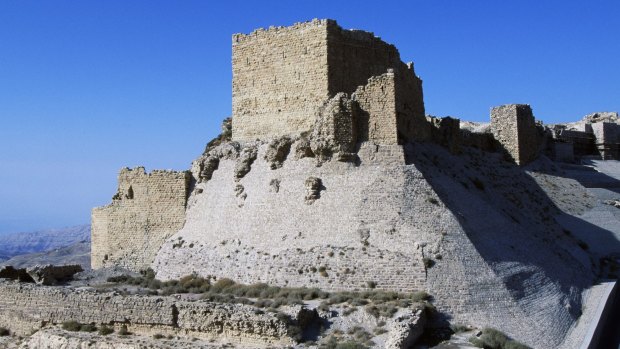
Though in ruins, the 12th-century castle of Al Karak still exudes a battle-scarred majesty.Credit: De Agostini / C. Sappa
Further north along the King's Highway, which runs from Amman, Jordan's capital, to Petra, is the crusaders' castle of Karak. I was lucky enough to see this, too, before the donkey incident. Perched on a hill above the highway, the limestone skeleton of Karak dates back to AD1142 when King Baldwin of Jerusalem built the castle as a handy earner, a way station for collecting taxes from passing caravans. Then 41 years later, it was besieged and finally conquered by the Muslim armies of Saladin, who had already been proclaimed Sultan of Egypt and Syria.
The castle's unsuccessful defender was its most notorious occupant, the sadistic Frankish knight, Renaud de Chatillon, who is said to have had his prisoners thrown from the castle's battlements with their heads encased in wooden boxes, the aim being to ensure that they remained conscious until they landed. Fans of Ridley Scott's Crusader epic Kingdom of Heaven will remember Irish actor Brendan Gleeson as de Chatillon, a man who antagonised Saladin so much, by violating a truce and plundering Muslim caravans, that he insisted on carrying out his execution personally, beheading him with his own sword.
Then, 80 years later, Karak was taken by the Mamluk sultan, Beybars. Former slaves who had united as a military force, the Mamluks carried on the war against the Crusaders with Beybars, extending the castle and strengthening its fortifications. If it hadn't been for his efforts, it might have suffered more damage in the earthquake which destroyed three of its towers in 1293 AD.
Its remains still exude a sense of battle-scarred majesty. I went in through the Ottoman's Gate, a bridge over the dry bed of what was once a moat to the first stop, the stables. From here, a flight of steps takes you down to the winding passage to the castle's original entrance, the Crusader's Gate. Its tucked-away nature is typical of fortresses of the period, when every stranger was viewed with intense suspicion.
Another staircase leads to the equally dark soldiers' barracks, lit only by narrow slits in the walls, and the kitchen with its huge oven. Move on through tunnels lined with chunks of limestone and you eventually come up again to the courts, terraces, mosque and keep thought to have been built by the Mamluks. The remains of a Crusader chapel are here, too. De Chatillon may have made worshipped in it, although it seems unlikely that he prayed for forgiveness after dispatching those who were pitched over the nearby parapet.
The final stop on my Jordan tour was the Marriott resort beside the Dead Sea. I had planned to coat myself in the Dead Sea's mineral-rich mud and float on its salty surface, reading a book, as they do in the tourist brochures, but the plaster on my foot put paid to that idea. I couldn't even manage to hobble the distance to the beach to take a look. Next time. For there will be a next time, donkeys or no donkeys. Jordan is a great holiday destination and unlike some of its oil-rich neighbours, it must rely on tourism for its economic stability. As they often say: Petra is their petrol.
TRIP NOTES
MORE INFORMATION
Tempo Holidays, 72 Market St., South Melbourne, Victoria 3205. Tel 1300 362844, 62 3 96460277. This company organises various tours tailored for groups and individual travellers. Prices include hotel accommodation, transport by bus or car with a driver and fees for guides at the sites you visit.
GETTING THERE
Emirates fly regularly to Amman, Jordan's capital, via Dubai. emirates.com.
STAYING THERE
Tempo Holidays use Marriott Hotel, Amman. Movenpick Resort, Petra. Jordan Valley Marriott Dead Sea Resort and Spa, all four to five-star hotels. Other grades are available.
SEE + DO
Supplement your tour of Petra, Little Petra and the ancient sites closer to Amman with a detour to the Crusader castles of Karak and Shobak, which are reached via the King's Highway. Return via the Dead Sea Highway and spend a night at one of the seaside resorts.
The writer travelled at her own expense.
Sign up for the Traveller Deals newsletter
Get exclusive travel deals delivered straight to your inbox. Sign up now.